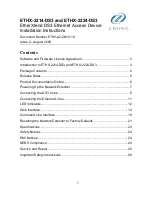
21
Routing loop prevention
RIP uses the following mechanisms to prevent routing loops:
•
Counting to infinity
—A destination with a metric value of 16 is considered unreachable. When a
routing loop occurs, the metric value of a route will increment to 16 to avoid endless loopings.
•
Split horizon
—Disables RIP from sending routing information on the interface from which the
information was learned to prevent routing loops and save bandwidth.
•
Poison reverse
—Enables RIP to set the metric of routes received from a neighbor to 16 and sends
back these routes to the neighbor so the neighbor can delete such information from its routing table.
•
Triggered updates
—RIP immediately advertises triggered updates for topology changes to reduce
the possibility of routing loops and to speed up network convergence.
RIP operation
RIP works as follows:
1.
RIP sends request messages to neighboring routers. Neighboring routers return response
messages containing their routing tables.
2.
RIP uses the received responses to update its local routing table and sends triggered update
messages to its neighbors. All RIP routers on the network do this to learn latest routing information.
3.
RIP periodically sends the local routing table to its neighbors. After a RIP neighbor receives the
message, it updates its routing table, selects optimal routes, and sends an update to other
neighbors. RIP ages routes to keep only valid routes.
RIP versions
There are two RIP versions, RIPv1 and RIPv2.
RIPv1 is a classful routing protocol. It advertises messages through broadcast only. RIPv1 messages do
not carry mask information, so RIPv1 can only recognize natural networks such as Class A, B, and C. For
this reason, RIPv1 does not support discontiguous subnets.
RIPv2 is a classless routing protocol. It has the following advantages over RIPv1:
•
Supports route tags to implement flexible route control through routing policies.
•
Supports masks, route summarization, and Classless Inter-Domain Routing (CIDR).
•
Supports designated next hops to select the best ones on broadcast networks.
•
Supports multicasting route updates so only RIPv2 routers can receive these updates to reduce
resource consumption.
•
Supports simple authentication and MD5 authentication to enhance security.
NOTE:
RIPv2 supports two transmission modes: broadcast and multicast. Multicast is the default mode using
224.0.0.9 as the multicast address. An interface operating in RIPv2 broadcast mode can also receive
RIPv1 messages.
















































